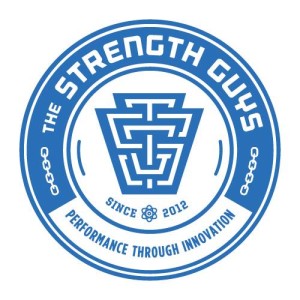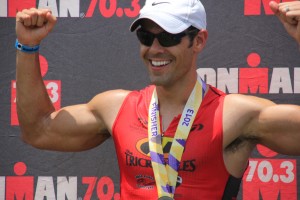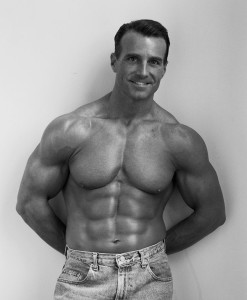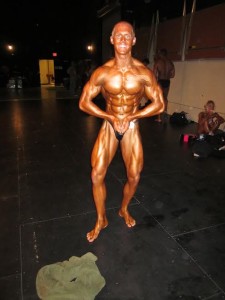BY CHRIS AND ERIC MARTINEZ
June 2014-
PLEASE VIEW THIS SHORT INTRODUCTION
QUESTION: For the goal of dropping body fat and retaining muscle mass, doing cardio is obviously an important factor. Given that an optimally designed resistance training protocol is in place, where do you stand on the controversial issue of whether HIIT or LISS should be done for the above purpose?
DAVID HUGHES
High intensity interval training (HIIT) has gained great interest in recent years, due to the scientific community highlighting it as an effective and time-efficient exercise strategy [1]. This is due to similar metabolic adaptations (e.g. carbohydrate and lipid oxidation), accompanied by enhanced maximal oxygen uptake and mitochondrial biogenesis being observed through shorter durations of exercise when compared to regular endurance exercise [2-4]. Mitochondrial biogenesis is the process by which new mitochondria are formed in the cell, with the mitochondria providing a major source for energy production (ATP) and regulating cellular metabolism. Subsequently an increased capacity for lipid oxidation (breakdown) by the mitochondria has been observed with HIIT and endurance training [5, 6].
Common HIIT protocols implemented utilize a number of “all out” sprints (4-7 x 30 secs) with varied rest intervals (1-2mins), performed 3 days per week [3]. Thus the total length of a session is ~ 15-20minutes max. Of particular interest, is the positive increase in the capacity for fax oxidation which has been observed with HIIT, even after only a 2 week intervention [7, 8]. Indeed, it is the alterations in lipid metabolism and fat oxidation, which makes it an attractive strategy to reduce body fat.
These positive benefits of HIIT exercise occur with a reduced total work time required by the individual compared to endurance training [3, 9]. It is important to note the studies reporting reductions in subcutaneous fat have usually implemented HIIT for 12-15 weeks [10, 11]. In terms of muscle mass retention with HIIT, there appears to be limited data, but performing at a maximum intensity would place greater emphasis on the anaerobic energy system and thus type II muscle fibre utilisation [12].
At the other end of the intensity spectrum is low intensity steady state (LISS) exercise, in which greater emphasis is placed on the aerobic system and the exercise performed for a longer duration of time (e.g. ≥30minutes @ 50% VO2 peak) [2, 13]. Commonly, aerobic exercise is performed at 50-65% VO2 peak intensity but ultimately, it should be noted that this is steady state in nature. At this intensity, similar adaptations occur to HIIT as already highlighted above (mitochondrial biogenesis etc.) which culminate in enhanced muscle oxidative capacity and increases in maximal oxygen uptake [2, 14]. Furthermore, performing at this intensity range has been observed to maximize fat oxidation rates in both the trained and untrained state [15].
The major difference between HIIT and LISS is the total work time undertaken by each strategy, with endurance training creating a greater negative balance and greater total work time. Interestingly, 24-hour substrate oxidation and energy expenditure appears not to differ between 40-70% VO2max [16-18] and is similar between HIIT and traditional endurance exercise. Finally, there is emerging evidence for type I muscle fibre hypertrophy with aerobic exercise alone [19-22]been observed and thus with an adequate resistance training protocol in place, increasing both muscle fibre type sizes would seem pertinent. Thus, whilst during resistance training, type II muscle fibres will be predominately activated, endurance training can target type I activation and provide the best of both worlds for whole muscle hypertrophy.
Take home message:
Ultimately, the physiological adaptations for both exercise strategies are similar in nature and thus provide two methods which can be used to support an adequate resistance training protocol. Indeed, the use of either method maybe a situational factor. For instance, limited gym time where HIIT might be used vs. a longer time period for running, cycling etc. LISS may be more beneficial for creating a larger calorie deficit for fat loss and given the high intensity of resistance training, could be more suited for active recovery and reducing potential injuries. Overall, these two strategies offer positive benefits for creating an adequate stimulus for fat loss, and influence on skeletal muscle adaptations.
*It is important to note a potential concurrent training effect, with the cross transfer of endurance training and resistance training on muscle adaptation. Although this may only be experienced with an extremely large volume/intensity from both training components [23].
References:
1.Gillen, J.B. and M.J. Gibala, Is high-intensity interval training a time-efficient exercise strategy to improve health and fitness? Appl Physiol Nutr Metab, 2014. 39(3): p. 409-12.
2.Burgomaster, K.A., K.R. Howarth, S.M. Phillips, M. Rakobowchuk, M.J. Macdonald, S.L. McGee, and M.J. Gibala, Similar metabolic adaptations during exercise after low volume sprint interval and traditional endurance training in humans. J Physiol, 2008. 586(1): p. 151-60.
3.Gibala, M.J., J.P. Little, M. van Essen, G.P. Wilkin, K.A. Burgomaster, A. Safdar, S. Raha, and M.A. Tarnopolsky, Short-term sprint interval versus traditional endurance training: similar initial adaptations in human skeletal muscle and exercise performance. J Physiol, 2006. 575(Pt 3): p. 901-11.
4.Little, J.P., A. Safdar, G.P. Wilkin, M.A. Tarnopolsky, and M.J. Gibala, A practical model of low-volume high-intensity interval training induces mitochondrial biogenesis in human skeletal muscle: potential mechanisms. J Physiol, 2010. 588(Pt 6): p. 1011-22.
5.Jacobs, R.A., D. Flück, T.C. Bonne, S. Bürgi, P.M. Christensen, M. Toigo, and C. Lundby, Improvements in exercise performance with high-intensity interval training coincide with an increase in skeletal muscle mitochondrial content and function. Journal of Applied Physiology, 2013. 115(6): p. 785-793.
6.Pesta, D., F. Hoppel, C. Macek, H. Messner, M. Faulhaber, C. Kobel, W. Parson, M. Burtscher, M. Schocke, and E. Gnaiger, Similar qualitative and quantitative changes of mitochondrial respiration following strength and endurance training in normoxia and hypoxia in sedentary humans. American Journal of Physiology-Regulatory, Integrative and Comparative Physiology, 2011. 301(4): p. R1078-R1087.
7.Perry, C.G., G.J. Heigenhauser, A. Bonen, and L.L. Spriet, High-intensity aerobic interval training increases fat and carbohydrate metabolic capacities in human skeletal muscle. Appl Physiol Nutr Metab, 2008. 33(6): p. 1112-23.
8.Talanian, J.L., S.D. Galloway, G.J. Heigenhauser, A. Bonen, and L.L. Spriet, Two weeks of high-intensity aerobic interval training increases the capacity for fat oxidation during exercise in women. J Appl Physiol, 2007. 102(4): p. 1439-47.
9.Deighton, K., R. Barry, C.E. Connon, and D.J. Stensel, Appetite, gut hormone and energy intake responses to low volume sprint interval and traditional endurance exercise. European journal of applied physiology, 2013. 113(5): p. 1147-1156.
10.Tjønna, A.E., S.J. Lee, Ø. Rognmo, T.O. Stølen, A. Bye, P.M. Haram, J.P. Loennechen, Q.Y. Al-Share, E. Skogvoll, and S.A. Slørdahl, Aerobic Interval Training Versus Continuous Moderate Exercise as a Treatment for the Metabolic Syndrome A Pilot Study. Circulation, 2008. 118(4): p. 346-354.
11.Trapp, E., D. Chisholm, J. Freund, and S. Boutcher, The effects of high-intensity intermittent exercise training on fat loss and fasting insulin levels of young women. International journal of obesity, 2008. 32(4): p. 684-691.
12.Egan, B. and J.R. Zierath, Exercise metabolism and the molecular regulation of skeletal muscle adaptation. Cell metabolism, 2013. 17(2): p. 162-184.
13.Volek, J.S., J.L. VanHeest, and C.E. Forsythe, Diet and Exercise for Weight Loss. Sports Med, 2005. 35(1): p. 1-9.
14.Gibala, M.J. and S.L. McGee, Metabolic adaptations to short-term high-intensity interval training: a little pain for a lot of gain? Exercise and sport sciences reviews, 2008. 36(2): p. 58-63.
15.Stisen, A.B., O. Stougaard, J. Langfort, J.W. Helge, K. Sahlin, and K. Madsen, Maximal fat oxidation rates in endurance trained and untrained women. Eur J Appl Physiol, 2006. 98(5): p. 497-506.
16.Skelly, L.E., P.C. Andrews, J.B. Gillen, B.J. Martin, M.E. Percival, and M.J. Gibala, High-intensity interval exercise induces 24-h energy expenditure similar to traditional endurance exercise despite reduced time commitment. Appl Physiol Nutr Metab, 2014. 6: p. 6.
17.Jakicic, J.M., B.H. Marcus, K.I. Gallagher, M. Napolitano, and W. Lang, Effect of exercise duration and intensity on weight loss in overweight, sedentary women: a randomized trial. Jama, 2003. 290(10): p. 1323-1330.
18.Melanson, E.L., T.A. Sharp, H.M. Seagle, T.J. Horton, W.T. Donahoo, G.K. Grunwald, J.T. Hamilton, and J.O. Hill, Effect of exercise intensity on 24-h energy expenditure and nutrient oxidation. Journal of Applied Physiology, 2002. 92(3): p. 1045-1052.
19.Harber, M.P., A.R. Konopka, M.D. Douglass, K. Minchev, L.A. Kaminsky, T.A. Trappe, and S. Trappe, Aerobic exercise training improves whole muscle and single myofiber size and function in older women. Am J Physiol Regul Integr Comp Physiol, 2009. 297(5): p. 19.
20.Harber, M.P., A.R. Konopka, M.K. Undem, J.M. Hinkley, K. Minchev, L.A. Kaminsky, T.A. Trappe, and S. Trappe, Aerobic exercise training induces skeletal muscle hypertrophy and age-dependent adaptations in myofiber function in young and older men. J Appl Physiol, 2012. 113(9): p. 1495-504.
21.Konopka, A.R. and M.P. Harber, Skeletal muscle hypertrophy after aerobic exercise training. Exerc Sport Sci Rev, 2014. 42(2): p. 53-61.
22.Ogborn, D. and B.J. Schoenfeld, The Role of Fiber Types in Muscle Hypertrophy: Implications for Loading Strategies. Strength & Conditioning Journal, 2014.
23.Hickson, R.C., Interference of strength development by simultaneously training for strength and endurance. European journal of applied physiology and occupational physiology, 1980. 45(2-3): p. 255-263.
Bio:
David C. Hughes is a molecular and exercise physiologist. He attained a BSc in Sport & Exercise Science and MSc in Exercise Physiology. He is in the later stages of his academic training (PhD-pending) investigating the role of exogenous testosterone in skeletal muscle hypertrophy and atrophy using skeletal muscle cell systems. Overall his research interests revolve around skeletal muscle plasticity and adaptations through various stimuli which accumulate in both hypertrophic and atrophic phenotypes. Twitter: @hughesDC_MCMP
THE STRENGTH GUYS
When it comes to weight loss I am of the opinion that HIIT should be the primary focus. LISS is traditionally used in bodybuilding circles but the research is pretty clear in dictating that HIIT provides better results in a timelier manner than LISS. The only issue with high intensity cardio is the impact that it has on the central nervous system. If HIIT is done too often I have noticed that my athletes will feel sluggish and their performance in the gym will start to suffer as well. The solution to this is to limit the amount of high intensity interval training that is performed to a reasonable range. If fat loss is still not sufficient with the current amount of HIIT being performed then I will either recommend that the athlete performs more intervals per session, or that the athlete performs some LISS cardio on other days for some added caloric expenditure.
It is not a matter of LISS being bad, it is just that HIIT is more effective. Ultimately I believe that there is room for both in a training program, but the adaptations that HIIT provides make it the go to option for fat loss cardio.
References
– Sim AY, Wallman KE, Fairchild TJ, Guelfi KJ. High-intensity intermittent exercise attenuates ad-libitum energy intake. International Journal of Obesity advance online publication 9 July 2013. [epub ahead of print]
– Townsend JR, Stout JR, Morton AB, Jajtner AR, Gonzalez AM, Wells AJ, Mangine GT, McCormack, WP Emerson NS, Robinson EH, Hoffman JR, Fragala MS Cosio-Lima L. Excess Post-Exercise Oxygen Consumption (EPOC) Following Multiple Effort Sprint And Moderate Aerobic Exercise. Kinesiology. 2013; 45(1):16-21
– Williams CB, Zelt JGE, Castellani LN, Little JP, Jung ME, Wright DC, Tschakovsky ME, Gurd BJ. Changes in mechanisms proposed to mediate fat loss following an acute bout of high intensity interval and endurance exercise. Applied Physiology, Nutrition, and Metabolism. 11 June 2013 [epub ahead of print]
Bio:
JasonTremblay
President of The Strength Guys Inc.
MENNO HENSELMANS
Very few of my clients do any cardio, but I see cardio as a necessary evil at the end of contest prep for many competitors. What’s wrong with cardio? Cardio is no more effective than calorie restriction at preserving muscle or getting lean. In fact, cardio significantly increases the risks of both muscle loss and overtraining.
The muscle loss from cardio is due to the interference effect. Your body cannot become good at endurance and strength training at the same time. These are mutually exclusive physiological adaptations. As a result, your body will find a compromise. Endurance and strength will both improve slightly. In a caloric deficit for an advanced trainee, the interference effect is often sufficient to prevent strength gains or even increase strength loss.
Note that I have competitive standards in mind, as most of my clients are currently physique athletes or want to look as good as one. The average fitness crowd that’s not interested in maximizing muscle mass can certainly combine cardio and strength training (Crossfit, anyone?), but if you’re serious about physique training, cardio is a necessary evil, not a desirable method of fat loss.
So if cardio sucks so much, why do it? At some point, it becomes necessary to avoid nutrient deficiencies, especially in women. Most of my male competitors get to below 2% body fat according to calipers (which of course systematically underestimate body fat percentage in this scenario) without any cardio.
However, most of my (natural) female competitors need to decrease their calories too much to get in contest shape, especially the bikini competitors who don’t have as much lean mass as the others. I very rarely have any of my female clients consume less than 1500 calories every day. It is almost impossible to consume a balanced and healthy diet at that point. Most women neglect their health, thinking it doesn’t matter for their body composition. They end up losing their period way too early and lose a lot of muscle mass when dieting to contest shape. I think the muscular potential of women is greatly underestimated in the fitness world. Most research shows women have a relative muscular potential close to that of men. Health and anabolism feed on each other.
When cardio becomes necessary to maintain a healthy diet and increase the caloric deficit further, LISS cardio is highly preferable to HIIT and both are better than anything in between. Avoiding the interference effect requires using a stimulus that is similar to strength training (HIIT) or a stimulus that does not require much adaptation at all (LISS). Avoiding the interference effect altogether is preferable to minimizing it, so LISS is best in this regard.
The female physiology is well adapted to endurance training and fat burning, so women do even better on LISS than men.
Thirdly, HIIT increases the risk of overtraining and injuries with no advantage to LISS other than saving time.
In summary, advanced male lifters generally don’t need cardio. Women tend to need cardio in the final weeks of contest prep to avoid starving themselves and in that case LISS beats HIIT.
See my article about cardio’s interference effect for a more detailed review of cardio’s risks.
Bio:
Bayesian bodybuilder, popular science author and online personal trainer, Menno Henselmans helps serious trainees attain their ideal physique using scientific and Bayesian methods. Follow him on Facebook or Twitter and check out his website for more free articles.
JOE KLEMCZEWSKI
So much has been written about this topic, and the newest research confirms that higher-intensity cardio burns more calories and more body fat. But, I would argue that we could be losing sight of other factors. If someone does ten minutes of killer-intensity cardio to maximize time, would thirty minutes accomplish the same, and perhaps be less catabolic? A high-intensity cardio can be as demanding as a leg workout; can that be done every day or three or four days per week? Some people enjoy cardio for reasons other than maximum body fat usage in the minimal amount of time.
My opinion is that high-intensity cardio is king. Even when cardio needs are low, such as in the off-season, I would always recommend keeping some high-intensity work in play. When’s the last time you worked on your mile time, week after week – or 5k improvement? High-intensity doesn’t have to be intervals. After one or two high-intensity sessions have been nestled into the week around leg workouts, I find that managing cardio like a college track coach or Olympic runner would, is best. They might only do high-intensity or speed work once a week, but there are tempo runs, over-runs, and recovery runs. The best answer is that there is room for all kinds of cardio for different reasons and goals.
Bio:
Joe Klemczewski, PhD, MS, MFA(c), BS, LPT, CSCS, CISSN
Founder: The Diet Doc, LLC, ALPHAmagonline.com, and Inspire-TheMovement.org
Licensed Physical Therapist
Certified Strength and Conditioning Specialist
Drug-free Pro Bodybuilder Founder, The Diet Doc LLC
JEREMEY LOENNEKE
It is important to note that my answer is specific only to a person looking to get lean (e.g. a physique athlete).
I think the ideal situation would be to do absolutely no cardio. I think often times people get carried away with cardio in the offseason and consequently end up requiring that plus some to drop fat when they do diet. With that being said, I think very few people can get stage lean without doing at least a little bit of cardio. Thus, if a person requires cardio to get lean, our meta-analysis on concurrent training suggests that higher intensity cardio may be better with respect to losing body fat. The data behind the benefits of high intensity interval training is starting to mount and I think it may be a time efficient alternative to regular steady state cardio. However, I don’t view intensity recommendations for exercise (cardio or weights) as an “all or nothing”. I see nothing wrong with mixing in some moderate intensity steady state exercise to help lean out if needed. The other factor to consider is the person. If the person absolutely hates doing HIIT, then prescribing them HIIT would likely be counterproductive to the goal of losing fat. If a person doesn’t like HIIT, they may not be completing the intervals with a high enough intensity to see benefits. In this situation, it may be necessary to program more moderate intensity steady state exercise.
One other important consideration for maintaining muscle may be the mode of exercise itself. There may be some muscle sparing effects of choosing cycle exercise over running/jogging. Much more work needs to be done, but it does appear that repeated bouts of running may negatively affect muscle much more than repeated bouts of cycling. This may be due to the more eccentric nature of running which when combined with regular training may negatively affect recovery, ultimately affecting the anabolic potential of skeletal muscle.
In conclusion, from a physique standpoint, I think people should do as little cardio as possible to get lean. If a person requires it, I would suggest making the majority of it HIIT with bouts of moderate intensity steady state thrown in if necessary. A person should never be doing a lot of cardio just to do a lot of cardio. Cardio is a tool to get lean; we aren’t trying to prepare for a marathon.
Bio:
Jeremy Loenneke is a PhD student in Exercise Physiology at the University of Oklahoma. He has previously earned a Master’s degree in Nutrition and Exercise Science from Southeast Missouri State University. He is also a competitive bodybuilder and powerlifter and proud member of Team Norton and the DRG. You can find him on twitter @jploenneke
JOSE ANTONIO
HIIT vs LISS – A Best Way to Lose Fat?
First let’s get the acronyms out of the way. HIIT stands for high-intensity interval training; LISS stands for low intensity steady state cardio. HIIT is sometimes abbreviated HIT. One form of training is hard and painful (HIIT) but doesn’t last as long whereas the other is not quite so painful (depending on how long you do it) but takes a longer amount of time. Is one better than the other for losing fat?
Before I give you the punch line, what’s the data say? With so many HIIT fanatics out there, one would think that doing LISS is a total waste of time. First of all, let’s change the definition for a second. I instead would call it SSC or steady-state cardio. Why? Just because its steady state does NOT mean it is low intensity. Try training with a collegiate distance runner on their ‘easy’ days. SSC in that case could be a sub-6 min per mile pace for several miles. You think that’s easy? Low intensity? Bwwaaaaah….You’re a fool if you think that’s easy.
So part of the answering the debate of SSC (LISS) vs HIIT is one of redefining SSC. SSC does not necessarily have to be easy. If it is, then you’re a jolly jogger and not a runner.
What’s the data say on SSC?
A long-term supervised aerobic exercise training program was administered to 41 obese children (21 boys, 20 girls) initially aged 11-years-old. The 2 year training program was performed during the daily school life. Lean body mass increased throughout the 2 year study while the total body weight decreased; the weight loss is attributed to a decrease in fat.(1)
What if we directly compared high intensity interval training (HIIT) versus continuous aerobic exercise training (CONT)? In 38 previously inactive overweight adults there was a significant reduction in android fat percentage in CONT but not HIIT. Wait. I thought HIIT was soooo much better? Guess not. The authors stated that “HIIT may be advocated as a time-efficient strategy for eliciting comparable fitness benefits to traditional continuous exercise in inactive, overweight adults. However, in this population HIIT does not confer the same benefit to body fat levels as continuous exercise training.(2)” Furthermore, aerobic exercise is an effective approach to reduce visceral fat besides in overweight male CKD patients.(3)
Certainly other studies confirm the benefits of traditional aerobic (i.e. SSC) training. Two months of aerobic cycling training improves body composition in young women.(4) Also, daily moderate intensity aerobic exercise is effective at reducing abdominal fat mass, while high intensity exercise improves cardiopulmonary function.(5)
HIIT better?
First of all, let’s get one thing clear. HIIT is not a new way of training. You can go back 70 years ago and find that famed distance runner, Emil Zatopek, was one of the first to utilize the interval training method. HIIT has been used by endurance athletes for decades. I find it somewhat amusing that folks in the ‘fitness industry’ feel like they’ve discovered some novel form of training. It’s the greatest thing ever some exclaim! Better than sliced bread, the zipper, and penicillin combined! So what’s the deal with HIIT? Does it burn fat fast?
Uh yeah.
In a recent study, HIIT was found to be more effective than SSC. The HIIT folks are saying “See, I told you so!” Geez, confirmation bias. In this study, 54 people with intellectual disabilities (not your typical sample) were trained via: sprint interval training (n = 17), continuous aerobic training (n = 15) or control (n = 14). “Compared with continuous aerobic training, sprint interval training seems to result in better outcome.(6)” Also, short-term low-volume HIT is a time-efficient strategy to improve body composition and muscle oxidative capacity in overweight/obese women.(7) In a fairly large study, 60 female university students were randomly assigned to either a HIIT group, the moderate intensity continuous training (MICT) group or a non-training control group. After 12 weeks of training, both type of training produced significant improvements in the subjects’ body composition, left ventricular ejection fraction, heart rate at rest, maximal oxygen uptake and ventilatory threshold. However, the HIIT group achieved better results than those in the MICT group, as it was evaluated by the amount of the effect size.(8)
Bottom line:
I think the HIIT vs SSC (or LISS) debate is somewhat misguided. If your goal is losing body fat and you don’t really give a shit about anything else, then by all means, you should do both. They BOTH work.
But honestly, changing your diet is probably as important (if not more important) then either. Doing HIIT is a great time-efficient way to train. Doing HIIT too often will likely result in some degree of overtraining. Let’s face it; to do HIIT correctly requires a high pain threshold. It should hurt. It should hurt a lot in fact! SSC is good in that you can do it quite frequently without too great a risk of injury and/or overtraining.
Dr. Stephen Seiler wrote a great article on interval training and long slow distance (SSC).http://www.sportsci.org/2009/ss.htm
Think of the 80:20 rule. Elite endurance athletes perform 80% or more of their training as SSC (i.e. intensities below the lactate threshold) with the remaining 20% being interval training (i.e. HIIT). It is intriguing in that when you look across a wide variety of endurance sports (i.e. cycling, running, rowing, cross-country skiing, etc), they all follow this distribution of training. Coaches (and athletes) have somehow figured out that if HIIT exceeds more than 20% of your training volume, it would likely have a diminishing or detrimental effect.
Thus, if we were to borrow from the lessons of elite endurance athletes, I’d suggest that you limit your HIIT to no more than twice per week. Any other cardio do beyond that should be SSC.
References:
1. Sasaki J, Shindo M, Tanaka H, Ando M, Arakawa K. A long-term aerobic exercise program decreases the obesity index and increases the high density lipoprotein cholesterol concentration in obese children. Int J Obes 1987;11(4):339-45.
2. Keating SE, Machan EA, O’Connor HT, Gerofi JA, Sainsbury A, Caterson ID, et al. Continuous exercise but not high intensity interval training improves fat distribution in overweight adults. J Obes 2014;2014:834865.
3. Baria F, Kamimura MA, Aoike DT, Ammirati A, Leister Rocha M, de Mello MT, et al. Randomized controlled trial to evaluate the impact of aerobic exercise on visceral fat in overweight chronic kidney disease patients. Nephrol Dial Transplant 2014;29(4):857-64.
4. Stasiulis A, Mockiene A, Vizbaraite D, Mockus P. Aerobic exercise-induced changes in body composition and blood lipids in young women. Medicina (Kaunas) 2010;46(2):129-34.
5. Kwon HR, Min KW, Ahn HJ, Seok HG, Koo BK, Kim HC, et al. Effects of aerobic exercise on abdominal fat, thigh muscle mass and muscle strength in type 2 diabetic subject. Korean Diabetes J 2010;34(1):23-31.
6. Boer PH, Meeus M, Terblanche E, Rombaut L, Wandele ID, Hermans L, et al. The influence of sprint interval training on body composition, physical and metabolic fitness in adolescents and young adults with intellectual disability: a randomized controlled trial. Clin Rehabil 2014;28(3):221-31.
7. Gillen JB, Percival ME, Ludzki A, Tarnopolsky MA, Gibala MJ. Interval training in the fed or fasted state improves body composition and muscle oxidative capacity in overweight women. Obesity (Silver Spring) 2013;21(11):2249-55.
8. Sijie T, Hainai Y, Fengying Y, Jianxiong W. High intensity interval exercise training in overweight young women. J Sports Med Phys Fitness 2012;52(3):255-62.
Bio:
Jose Antonio PhD – CEO – International Society of Sports Nutrition
Hope to see you at the 11th Annual ISSN Conference and Expo, June 20-21, 2014 at the Hilton Clearwater Beach, in Clearwater Beach FL, USA
Check out the latest book, Sports Nutrition & Performance Enhancing Supplements, eds. Abbie Smith-Ryan and me.
Follow the ISSN on Twitter @DrJoseAntonio – https://twitter.com/DrJoseAntonio
Follow the ISSN on Instatgram the_issn http://instagram.com/the_issn
Follow our wonderful discussions on https://www.facebook.com/groups/TheISSN/
Read the awesome ISSN Position Stands! http://www.jissn.com/series/ISSNPosP
JOY VICTORIA
HITT or LISS to keep the muscle and lose the fat? Basically, exercise recommendations need to fit the right context of circumstances for the person training. There is a big difference between a bodybuilder getting shredded for the stage and a business man wanting to lose his belly. Any recommendation would depend on their:
1. Training level
2. Diet
3. Schedule
4. Recovery ability and energy levels
That’s not necessarily in order of importance either.
Higher intensities are best for getting leaner IMO, because they train the energy pathways with the greatest impact on metabolism and also take less time. But one or the other are both tools, and you can get good results with either if you fit the recommendation to the context. Adding HIIT to someone that already has a good intense weight training schedule and is in a caloric deficit might tip the scale to burning out and make it a bit too stressful on their body and actually make them lose muscle if they can’t recover properly. In that case, LISS could be a better recommendation, as they are already dipping pretty deep into their energy reserves being in a deficit, and the priority is to keep their weight sessions going well. High intensity = higher recovery right? Low intensity = low recovery. LISS would add that extra deficit for fat loss, but without the accompanying stress of higher intensity cardio that could impact recovery. Always ask; “What is sustainable, enjoyable and gives you the least amount of stress mentally and physically while driving progress.” That’s it.
I favor HITT for my own cardio and my clients, and according to both research and anecdote it trumps LISS for burning fat given the time considerations and the metabolic adaptations. For most people I like to recommend cardio that carries over to their weight training as well, and HITT fits this format better than LISS from a physiological point of view. Another consideration though, is that HITT is HIGH intensity! That means I have to be sure that my clients can do movements or exercises with enough intensity correctly. I don’t usually find that’s too much of a problem unless someone is very de-conditioned, injured or new to any kind of exercise, and then LISS might be more appropriate as they build their strength base and work up to a higher training level. Personally I love to use hill sprints, kettlebell circuits and types of sled pushes/pulls and some strongman style stuff like tire flips for instance. This type of HITT enhances their strength training, utilizes the energy systems I want, and gets the greater metabolic effect I want as well = better fat loss. A plus is that a lot of people also enjoy the mental challenge of HITT, and especially for those that are just building their strength base, when weights cannot feel like “much of a workout”, I find that the HITT fills the need for them to feel like they did “enough work”.
Cardio is a tool, and which one you “think is better” just depends on the variables and what is needed. So I guess the answer is; it depends. What do you respond best to? What do you enjoy? And what results do you want from your exercise?
Since I train a lot of women, I have to put a little disclaimer in here. A lot of the information about exercise that women are exposed to has the perpetual “eat veggies, do cardio” theme. I do feel the need to steer women away from that mindset and educate them about training, and help them understand why moderate or low intensity cardio is not the best way to lose fat and keep it off. I emphasize weight training, sufficient calories/macros and use HITT as the cardio of choice for the most part.
For a more in-depth analysis of this question, including research references I would suggest these links below from Alan Aragon, and Alwyn Cosgrove:
“The body of research strongly favors high-intensity interval training (HIIT) for both fat loss and lean mass gain/maintenance, even across a broad range of study populations [9-12].”
http://www.alanaragon.com/myths-under-the-microscope-the-fat-burning-zone-fasted-cardio.html
“It (HITT) burns more calories than steady state and elevates metabolism significantly more than other forms of cardio. The downside is that it flat-out sucks to do it!”
http://www.t-nation.com/free_online_article/sports_body_training_performance/the_hierarchy_of_fat_loss
MICHAEL TUCHSCHERER
It’s important to look at your options as tools to be used that have advantages and drawbacks. Any coach who recommends a hammer for every situation is, at best, not appreciating the diverse set of contexts that occur in the real world.If we’re talking about for strength, I’d suggest avoiding lactic work at least during the pre-competition and hypertrophy periods. This precludes a lot of HIIT protocols. This is because being in a lactic environment is counter-productive to the goals of the training period. But when you need to develop aerobic capacity, then what do you do? LISS can be a very helpful tool. Walking or (God forbid) jogging a few miles won’t turn you into a catabolic nightmare.In the same way, if we’re talking general recommendations for large populations of physique-minded trainees, then I’d lean toward high intensity stuff. But the energy system work has to cooperate with the big picture too. LISS work (depending on the precise protocol involved), can help autonomic tone among other things, which can help people recover faster. So if you’re in a stage of training where you’re really pushing the weights with lots of volume, then moving toward LISS as your cardio option could help you better tolerate the volume. Again, it depends on the precise protocol that you use, but it’s clearly a much more nuanced situation than just choosing one or the other.
ALAN ARAGON
For the specific goal of body fat reduction while maximizing lean mass retention, the objective should be to do the least amount of cardio necessary to get the job done. With that foundational principle out of the way, the type of cardio should be determined by the personal preference & tolerance of the individual. Whether someone does hour-long moonlit walks, 30-minute jogs, or 10-minute Tabata drills (or any combination or rotation of those) should be left to the preference of the trainee, because they all can be effective.
Several factors can determine the choice of cardio type. Schedule restraints, volume/exhaustiveness of the resistance training program, orthopedic limitations, and other clinical limitations can all influence which mode is chosen. For example, if someone is short on time and patience but has sufficient tolerance or conditioning, then they might go with higher-intensity/shorter-duration cardio. Conversely, if someone has cardiac or orthopedic limitations (or injuries), and they have a lot of time to kill, then they might opt for some lower-intensity/longer-duration cardio. Both types will work similarly, and going with personal preference will result in better adherence to the program.
There’s nothing “magic” about any particular type. Studies comparing types of cardio typically show the superiority of high-intensity interval training (HIIT), but almost invariably; this comparison is not done under conditions where a progressive resistance training program is also in place. This limits the relevance of the positive HIIT findings to programs that are cardio-only. So, to sum up, go with what you personally prefer, but do the least amount necessary to keep progress humming along; you can always raise volume and/or intensity incrementally as needed.
Bio:
http://alanaragonblog.com/aarr
ERIC HELMS
Some critical information should be noted before we compare of the pros and cons of high intensity interval training (HIIT) and low intensity steady state (LISS) cardio. One is that similar metabolic adaptations can come from either HIIT or LISS; the primary difference is the time course (adaptations happening faster and with less total time dedicated when using HIIT)1. Secondly there is concern that aerobic training can reduce the adaptations from resistance training (hypertrophy, strength and power)2. Thirdly, this risk seems to be avoided when HIIT is utilized3. Lastly, the higher the intensity, the greater the increase in metabolic rate in the short term period afterwards. High intensity exercise provides a short term, small, but significant increase in metabolic rate4 while LISS training by function of being low intensity does not.
The above suggests that HIIT is a home run. It gets the same adaptations in a fraction of the time, takes less time to burn the same amount of calories, helps you burn a small amount of calories acutely after performing it, and unlike lower intensity training, may not interfere with resistance training adaptations.
However, let’s think critically. What is low intensity? In many of the studies this means endurance training. Exercising at 60-70% of VO2 max, which might not compare to what many people do for LISS. In fact, the mechanisms of interference seem to be related to glycogen depletion and molecular signaling that comes from endurance training5. But, rarely do exercisers do glycogen depleting cardio at these intensities when they perform LISS. Interference might also be related to the extent of the impact and the contribution of eccentric contractions to the modality of cardio, considering that cycling appears to interfere less with resistance training adaptation than incline walking6.
So we need to be clear that endurance training is not always the same thing as LISS. However, if the LISS performed resembles endurance training, has a significant eccentric component, and/or if it has a high impact it may interfere with resistance training adaptation. So really it is a case of choosing the proper modality and intensity versus shunning LISS altogether.
But the question remains, why do LISS at all? Even if you could avoid the interference, why not burn more calories and acutely increase your metabolic rate? Well, now we have to really think about what HIIT is. HIIT by definition is high intensity, which means it provides high stress, which is why less HIIT creates the same adaptations that more low intensity training produces. But, stress has to be recovered from. You can’t do HIIT in a vacuum. HIIT occurs in the same week that you have to weight train, and if you are still recovering from HIIT to the point that it affects your ability to lift weights, that can be detrimental. It becomes a question of not whether LISS or HIIT is better for maintaining muscle, but rather HIIT or lifting weights (the answer should be obvious)?
The same issues that I just discussed regarding LISS apply to HIIT. If there is a significant eccentric component, or a high level of impact, HIIT can cause problems. In fact, sprinters suffer more than twice the number of hamstring injuries that long distance runners suffer on average, despite running only a fraction of the distance or time7. While a larger risk of injury (with certain modalities) and a greater need for recovery are the only risks of HIIT, they are significant risks. It’s hard to make the argument that you are retaining more muscle than the guy doing the slow cardio while you are on crutches. Lastly, I want to point out that the metabolic benefits of HIIT are a function of their high intensity. Typically HIIT is performed with 10-30secs of maximal intensity effort, followed by 30-90secs of low intensity recovery. This work to rest ratio very closely resembles that of weight training. If you are lifting weights 3-6 times per week, any beneficial physiological adaptations from HIIT may already exist. This similarity is why HIIT doesn’t cause interference. But, just like you wouldn’t train the same body part every day of the week, it probably wouldn’t be wise to do HIIT every day of the week, as it would affect your body in much the same way.
So, let’s talk application. Cardio should not be the primary vehicle for fat loss, regardless of whether it’s HIIT or LISS. The majority of fat loss should come from the diet. Secondly, resistance training performance is the most critical aspect to muscle maintenance. The diet supports the training as best as possible while creating fat loss and the training supports muscle retention. Don’t put this paradigm at risk. Choose cardio that is easy on the joints (low impact) and easy on the muscles in subsequent days (won’t make you sore). Then it comes down to balance. Cap the number of HIIT sessions at one to three per week in most cases, and only the most robust, young males who can take a big beating should do three sessions per week. For LISS, make sure to keep it from being endurance training; keeping intensity below the 60-80% of VO2 max range where most of the issues with interference occur (that is unless cardio respiratory endurance is also a goal).
References:
1. Burgomaster KA, Howarth KR, Phillips SM, et al. Similar metabolic adaptations during exercise after low volume sprint interval and traditional endurance training in humans. J. Physiol. Jan 1 2008;586(1):151-160.
2. Wilson JM, Marin PJ, Rhea MR, Wilson SM, Loenneke JP, Anderson JC. Concurrent training: a meta-analysis examining interference of aerobic and resistance exercise. J. Strength Cond. Res. Oct 13 2011.
3. Balabinis CP, Psarakis CH, Moukas M, Vassiliou MP, Behrakis PK. Early phase changes by concurrent endurance and strength training. J. Strength Cond. Res. May 2003;17(2):393-401.
4. Borsheim E, Bahr R. Effect of exercise intensity, duration and mode on post-exercise oxygen consumption. Sports Med. 2003;33(14):1037-1060.
5. Hawley JA. Molecular responses to strength and endurance training: are they incompatible? Appl. Physiol. Nutr. Metab. Jun 2009;34(3):355-361.
6. Gergley JC. Comparison of two lower-body modes of endurance training on lower-body strength development while concurrently training. J. Strength Cond. Res. May 2009;23(3):979-987.
7. Lysholm J, Wiklander J. Injuries in runners. The American Journal of Sports Medicine. March 1987 1987;15(2):168-171.
Bio:
Eric Helms MPhil MS CSCS
Professionally Qualified Natural Bodybuilder, Raw Powerlifter
Team 3DMJ Coach
www.3dmusclejourney.com
MIKE ORMSBEE
I’m going to assume that in this situation, the individual has taken care of caloric intake, macronutrient profile, and some other critically important nutrition and supplement needs. With that in mind, then this issue becomes much easier to answer. In my experience and in our lab, we have found that HIIT (combined with an optimal resistance training protocol) is ideal for losing body fat and maintaining muscle compared to the typical recommendation of “30 minutes per day most days of the week” (Arciero et al, 2006; Link: http://www.ncbi.nlm.nih.gov/pubmed/1713694.).
The intensity needed is going to be quite difficult to keep up though for a really good HIIT session. I would say that including 2-3 days per week of HIIT and incorporating LISS for active recovery or rehab scenarios would be ideal for maintaining muscle and losing body fat. Also, using many different styles of training will keep your body fit in a number of ways, which should help reduce the chance of injury and will also help to lean you out. One key to all of this, however, is fueling properly to maintain muscle and lose body fat along the way.
Bio:
Michael J. Ormsbee, PhD, CSCS
Florida State University, Assistant Professor, Department of Nutrition, Food & Exercise Sciences
Human Performance & Sports Nutrition Lab
Twitter: @mikeormsbee
JOHN MEADOWS
I am going to keep this short because I know you have other folks that can present some pretty cool data in terms of physiological response. I am going to give you my common sense approach that I use with athletes where it is imperative that we save (or build muscle), and we get as lean as possible for competitions.
My business is centered around people trying to gain the maximum amount of muscle they can and periodically peaking to insanely low levels of body fat periodically. So keep that in mind, as that is the context of which I am coming from, not trying to get a beginner in a little better shape.
Don’t assume you have to do cardio to get leaner. Before you make that assumption, try to train more. Now how can you train more? You periodize your program and you bust ass number one. I always get a good laugh at all the people who fear the overtraining boogeyman. Most of these people don’t even look like they lift weights. Next you use the right kind of nutrients during training to minimize muscle protein breakdown. I have seen hundreds upon hundreds of people do this successfully. You greatly reduce soreness, and you can train more when you use this approach. That’s a whole separate topic though.
Ok so now that you can train more, and aren’t as beat up, hit the weights more. Half of your sessions can be ball busting with a wide variety of rep ranges and high intensity techniques, while the other half can be more pumping (very painful) in nature, and easy on joints and connective tissue. You can train more, and train safely.
Now that you are training more with weights, you will lose more fat. This is my belief based on what I have seen anecdotally. The people that I work with who look the best are the ones NOT doing tons of cardio.
Ok, so let’s say you have now maxed out training, but still need to boost fat loss. I would add in some LISS. Why? It will not create too much CNS stress and interrupt recovery, plus it will burn some more calories. Your body will adapt to this pretty quickly though, so its effectiveness will be short lived. Don’t just keep increasing more and more sessions unless you want your body to think you have taken up endurance sports, as its responses will be in kind. You will not like the way you look if this happens. Instead I would add in some higher carb reefed type meals to provide a lot of energy and crank out a few HIIT sessions a week. I wouldn’t go overboard on this either. Too much and your body will struggle to recover from all the weight sessions, and the HIIT sessions.
Do you see where I am going with this? No matter what type you use, use it judiciously, and use resistance training, the kind where you bust your ass, as your primary form of exercise.
Bio:
John Meadows C.S.C.S, C.I.S.S.N.
Creator of Mountain Dog training and nutrition
http://www.mountaindogdiet.com/
ADEL MOUSSA (PROFESSOR ANDRO)
Just like “cardio”, itself, talking about “cardio” can be a pretty exhausting and time consuming thing. Therefore, I am trying to cut myself short: There are three forms of “cardio”.
– Useless “cardio”: Useless “cardio” is usually performed on some funky “cardio equipment” in a gym, where people you just have to look at to know that this effort is futile are doing “their cardio” in something someone once called the “fat burning zone” for 20-40min.
– Detrimental “cardio”: Detrimental “cardio” is usually performed in the very same “cardio zone” of a gym and at a similar intensity of ~70%-80% of the trainee’s heart rate max. The exercise duration is yet constantly increasing from 45min, when the craze began to 90-120min, when the poor victims of the calorie counters on the treadmill, steppers, elliptical, ergometers and other masochist torture instruments realize that they are getting fatter and fatter despite “doing their cardio” like maniacs.
Thank God, there is a third version of “cardio”! I mean, otherwise I could have saved my breath and said: “There is just one form of cardio that’s worth it: No cardio!” I don’t know if you already realized that, but you’re usually going to hear that from the “I rest for 5min+ after each set” faction who fails to realize that they are those trainees who would be in greatest need to perform some…
– Goal-oriented “cardio”: Goal oriented “cardio” is best performed outside the gym – on the track, in the city, at the beach, in the water, on the bike, in the snow or wherever else you can be (a) active just for fun to maintain or do (b) high intensity interval training (max. 20min) to improve your conditioning.
Ah, I almost forgot: Useless “cardio” and detrimental “cardio” are often misunderstood as fat loss instruments; and in fact, they can be: For the “biggest losers”, the absolute beginners and those who have been following someone’s stupid advice that “only no cardio is good cardio” for too long. For these people training in the “fat burning zone” may actually be a challenge. For all the rest, it is a mere test of their mental toughness.
Remember: Fat loss is about dieting – exercise is about performance. You diet to cut body fat and you train to maintain your cardiovascular fitness, strength and muscle mass.
Bio:
Adel Moussa, www.suppversity.com
ALBERTO NUNEZ
Let me start off by saying that if your main goal is to lose body fat, and retain lean body mass under most circumstances cardio is not essential. It’s helpful, but in no way is it a must have. For the majority of fat loss goals you don’t NEED cardio, it can however help accelerate the process a bit. Also for people who diet on lower calories (usually smaller women or folks who are sedentary outside exercising) it can make dieting a bit easier because it allows you to eat a bit more. Not to mention eating a few extra calories can help keep performance, and also help with adherence to the diet. Funny what an extra 1/4 cup of oats can do for you.
Now when it comes to what kind of cardio I prefer?
I am a fan of low intensity steady state cardio. Unless being good at cardio is one of your goals of course,.I don’t think most people require much more than just some walking on a treadmill. Nothing extreme either, but a moderate speed walk at a 5-7% incline will fit most. I like walking because it’s something most of us are good at and have been doing for a while (at just under 8 months in my mother loves to brag) and it won’t cause those adaptations that work against our anaerobic ambitions. On the exact opposite side of the spectrum you have something like high intensity interval training, in the form of sprints for example. While I am on the topic of sprinting most people(adults far removed from their athletic days mostly) have absolutely no business sprinting and to someone like me from a track and field background most people running look something like this to me.
http://www.youtube.com/watch?v=P0ySblouCKs
Yeah and ouchie waiting to happen
Back to the topic…
My main beef with HIIT is that if you are weight training when in a deficit recovery will surely slowdown just a bit, and when you combine your training load with more training in the form of HIIT it can be a recipe for disaster. Too much stress for the organism to adapt from which can in turn lead to drop in performance in the gym, and in some cases even injury. Both are not optimal for muscle maintenance by the way.
Now purely anecdotal, but in my experience I have seen that if you push people too much and for too long with with an overdose of HIIT you actually see less favorable fat loss which is the bottom line here anyways. Still HIIT nothing works better for fat loss than HIIT, but there is some small print attached. So what do I recommend?
The majority of your cardio should be done via non-invasive methods such as LISS, and HIIT should be pulsated in and out of the fat loss diet. Just how we periodize our weight training, invasive forms of cardio should be managed in a similar fashion. So even though I am a fan of cardio-less fat loss phases, and if cardio has to be used I want it to be primarily LISS, I still see rhyme and reason for HIIT. Just not in the way it’s conventionally used within our bodybuilding community, but this goes for all forms of cardio in general.
Bio:
Alberto Nuñez
Lifetime Natural Bodybuilder and Powerlifter
IFPA Professional Bodybuilder
Team 3DMJ Coach
http://www.3dmusclejourney.com/team-3dmj.php
TOM VENUTO
When you ask which is better for dropping body fat and retaining muscle mass, LISS or HIIT, one problem is that you set up a dichotomy, as if there are only two choices and only one is best. Also, intensity is not a switch you set either on high or low — it’s more like a dial. Cardio can be prescribed through a range of intensities and durations. Here’s the quick and simple answer: Want more fat loss? Push yourself. Turn up the intensity dial regardless of the type or mode. High intensity cardio that burns more calories will produce more fat loss, period.
The longer answer is, it depends on each individual’s needs and on the type, intensity, frequency, and duration variables you are comparing. HIIT usually wins for effectiveness, and always for efficiency. But that depends on what you mean by LISS or HIIT. By LISS do you mean a one hour walk? A ten mile run? Or 45 minutes nonstop at the highest level you can sustain? I’ve heard all of those called LISS. By HIIT do you mean one 4-minute Tabata series, eight 30-second sprints, or ten rounds of 60 second intervals? I’ve heard all those called HIIT.
Most people only associate steady state with low intensity. But what if you do approximately 30-45 minutes steady at the highest intensity you can tolerate? I call this highest intensity steady state (HISS) cardio. HISS cardio acknowledges that there’s an intensity dial and that the total amount of calories burned is a product of intensity times duration. This is just my anecdote, but I find HISS incredibly effective – light years ahead of LISS and equally or more effective than brief HIIT workouts (although it requires more time).
Lowering intensity hoping to get into the mythical “fat burning zone” is misguided. That will burn fewer calories! To maximize fat loss, do the opposite: However much time you have – 4 minutes, 15 minutes 30 minutes, 45 minutes – whatever, the more intensely you work in that time, the more calories you’ll burn and the more body fat you’ll lose.
Although HIIT wins for efficiency, I’m critical of claims that very brief HIIT (such as 4 minutes of sprints), will burn more calories and get you leaner than 30-45 minutes of HISS, and I’ve never seen the two fairly compared. It IS possible that you could burn twice the calories in half the time (for example, 15 minutes of high intensity will easily burn more than 30 minutes of low intensity walking). But keep in mind that no matter how intensely you train, you can only burn so many calories per minute. Maximum fat loss is achieved when you hit the sweet spot in the middle where intensity multiplied by duration equals the highest accumulated calorie burn, inclusive of EPOC.
Walking can contribute nicely to weight loss and maintenance over time. The problem is that very low intensity, long duration exercise is inefficient. It doesn’t burn many calories per unit of time. When you’re physically able to do so, I believe including some high intensity cardio in your plan is very important to maximize fat loss. Otherwise you’ll need hours of LISS exercise every week and it’s going to be a longer haul to get to your goal.
When your goal includes retaining maximum muscle as well as burning fat, the prescription requires more thought. A large body of research on concurrent endurance and resistance training has shown that too much endurance work interferes with strength and hypertrophy.
The research suggests a prescription in the range of 2 to 4 days per week for 20 to 40 minutes of moderate to intense cardio can be combined with resistance training with little or no interference effects. Do more, especially with intensity, and the risk goes up. Negative effects of more frequent cardio sessions can be minimized with proper nutrition, progressive resistance training and periodization of the cardio (such as alternating low and high intensity workouts). But when your cardio program starts looking like an endurance athlete’s regime, you’re surely compromising your strength and muscle gains.
Recent research has confirmed some finer distinctions about the best cardio for fat loss while retaining muscle. First, it appears the type matters. Most bodybuilders avoid jogging, claiming that it cuts down their leg size. A recent meta-analysis by Jacob Wilson confirmed that hypertrophy is compromised more from running than cycling. Second, studies are looking at cardio timing. Due to the residual fatigue factor, some research suggests separating intense cardio and resistance training (especially legs) by at least 8 hours (some even suggests we separate cardio and leg training sessions by 24 hours). Third, research has compared steady state mode versus intervals and found that short, intense sprint intervals are superior to long duration traditional cardio for retaining lean mass, provided the workouts are brief and limited to 3 sessions per week.
There’s some irony in that the average overweight or unfit person probably can’t duplicate “the best” high intensity protocols that were tested and proven in the research. It’s one thing to identify what’s optimal; it’s another to identify what’s practical for each individual. There’s also personal preference to consider. If someone hates a certain type of training, the odds are against good compliance. Gimbal’s study found that 8-12 rounds of 60-second intervals with high, but not maximum intensity produced significant results with just 3 sessions per week. The conclusion was that HIIT does not have to use all-out (“puke-inducing”) sprints to be effective.
More info: http://www.burnthefatinnercircle.com/members/Practical_Interval_Training.cfm
LISS has a welcome place in certain situations. High intensity exercise could be dangerous if you’ve been sedentary for life, if you don’t have your doctor’s approval for vigorous exercise, if you’re obese, or if you’re susceptible to orthopedic stress or joint problems. I’ve lost count of how many pulled hamstrings I’ve heard about from people leaping into sprints after reading an article about HIIT and doing it before they were ready. For many people who are overweight, combining resistance training with LISS exercise such as walking is an ideal choice (and diet will be the real fat burning workhorse).
There’s no single best type of cardio for everyone. Low, moderate and high intensity exercise can ALL help you burn fat. When intensity is low, it simply takes much more time and volume to get the same results. If the type, frequency, duration and mode aren’t carefully chosen, you could also compromise strength and muscle gains.
CLICK HERE to discuss this article in the Burn the Fat Cardio forum
References
Gibala MJ et al, A practical model of low-volume, high intensity interval training induces mitochondrial biogenesis in human skeletal muscle: potential mechanisms. J Pphysiol. 2012, 588(6): 1011-1022
Wilson J, et al, Concurrent Training: A Meta-analysis examining interference of aerobic and resistance exercises, J Strength Cond Res, 26(8); 2293-2307, 2012
PETER FITSCHEN
Thanks for the opportunity to participate in this round table. This is an interesting topic that is starting to develop a body of literature. Most of the literature would suggest that HIIT cardio is superior to steady-state cardio; however, from practical application I would argue that steady-state cardio may have a place as well.
Looking at the literature, an early study comparing HIIT and steady-state cardio found increased fat loss (as measured by calipers) with HIIT as compared to steady-state cardio in less overall total cardio time [1]. However, it should be noted that since body fat was measured by calipers, these results need to be replicated with more modern and precise measures of body composition and muscle/fat mass, such as DEXA, bodpod, MRI, etc. More recently, many studies have observed a reduction in strength/size gains when cardio was added to strength training. This is likely due to the fact that many of the muscular adaptations to endurance training and strength training are conflicting. A recent meta-analysis by Dr. Jacob Wilson’s lab observed less interference with strength, hypertrophy, and power with lower cardio frequency, duration, and higher intensity [2]. Based on these results, performing as little cardio as possible, preferentially of high intensity, appear to be the most beneficial for fat loss and muscle maintenance during contest prep.
Although the literature may suggest that HIIT is preferential to steady-state cardio, from practical application we know that HIIT is more difficult to recover from than lower-intensity forms for cardio. Therefore, there may be a limit to the amount of HIIT an individual can recover from. Recovery may also be reduced while in a caloric deficit which may further impair recovery from both strength training and cardio.
Based on the combination of research and practical application, my recommendation would be to keep overall cardio frequency and duration as low as possible while still making progress. I would also emphasize that focus of a dieting bodybuilder in the gym should be lifting weights to maintain muscle mass, not doing cardio. If cardio does need to be added to keep fat loss moving during contest prep, I would preferentially use HIIT cardio up until the point at which no more HIIT can be added without impairing recovery for strength training. At that point I would add in steady-state cardio for any additional cardio needs. However, I would again emphasize that bodybuilders are strength athletes, not endurance athletes, and overall cardio time should be minimized as much as possible while still making progress.
References:
- Tremblay, A., J.A. Simoneau, and C. Bouchard, Impact of exercise intensity on body fatness and skeletal muscle metabolism. Metabolism, 1994. 43(7): p. 814-8.
- Wilson, J.M., et al., Concurrent Training: A Meta Analysis Examining Interference of Aerobic and Resistance Exercise. J Strength Cond Res, 2011.
Bio:
Peter Fitschen is a PhD Candidate in Nutritional Science at the University of Illinois. He has a BS in Biochemistry, MS in Biology with a Physiology Concentration, and is a Certified Strength and Conditioning Specialist (CSCS) through the National Strength and Conditioning Association. He is also an NGA Natural Pro Bodybuilder who has competing in natural bodybuilding since 2004 and a contest prep coach through Fitbody and Physique LLC.
BE SURE TO CHECK OUT THESE OTHER ARTICLES BY SOME OF THESE EXPERTS:
- – Want to Build Muscle and Lose Fat? Lets Ask the Experts How its Done…
- – Want to Learn How to Squat? Lets Ask the Experts How its done…
- – 15 Nutrition Myths You Want to Know…Allow the Experts to Tell…
- – 18 Nutrition Myths You Want to Know…
SEE OUR ULTIMATE HIIT CARDIO GUIDE PRODUCT
CHECK US OUT ON:
